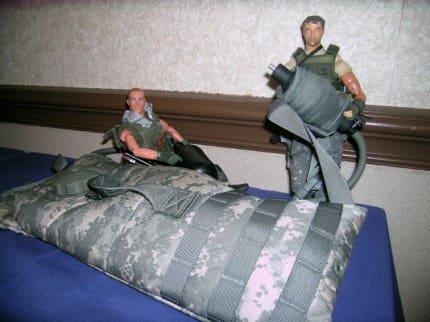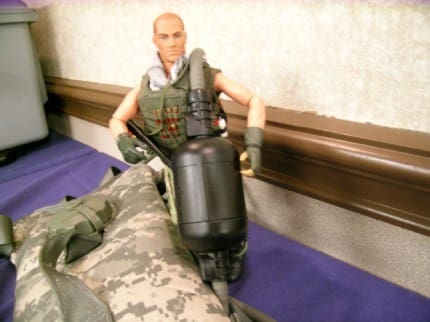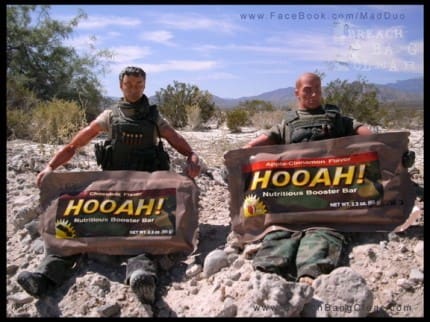Thirteen centuries ago or so, JÄbir ibn HayyÄn distilled water to purify it. Ten centuries ago, Avicenna espoused the straining of water through a cloth, or boiling it (or both) to make it safe to drink. Four centuries ago, Sir Francis Bacon published the results of numerous experiments on percolation, boiling and distillation for the purification of drinking water. Three centuries ago, Joseph Amy was granted a patent for a water filter design. Approximately one century ago, Maj. (later BG) Carl Darnall devised a chlorination system for water supplies, three years after which Maj. (later Col.) William Lyster invented the ‘Lyster Bag’ for the chlorination of drinking water in the field.
Three weeks ago, Darley Defense showed us an in-line filter system for a “reservoir backpack†style hydration system, complete with a small, lightweight pressure pump.
It was definitely one of those forehead-slapping moments. We at Breach-Bang-Clear think it’s one of the coolest things to come down the pike since peanut butter, the multi-tool and x-ray glasses. This thing is going to become as common and ubiquitous as the hydration systems themselves. (If you’re as old as we are, you remember what it was like when CamelBaks first came out, and how kewl they were compared to the standard one-quart canteens we used to lug around on our TA-50 or 782 Gear). This system will fit them all, CamelBak, Hydrapak, Platypus, Coleman or any of the others.
This filter system effectively marries up pieces of equipment already in use to make a unique piece of kit that capitalizes on the strengths of both. It utilizes filters already in use by the British Army and Royal Air Force (Pure Hydration) and a pressure/pump system by Ogwa. The prototypes we saw were less than a month old, but a lot of people have already shown a lot of interest in it.
“I’ve shown it to USASOC and Natick, and they both think highly of it,†said TJ Gilroy (he’s the manager of Darley’s Defense Division, and the one developed this as-yet-unnamed system). “There’s also an ODA from an SFG that’s deploying with them now, but we haven’t gotten any formal AARs yet.â€
You see, the problem with any in-line filter is that it takes a certain amount of pressure to get water through it, applied by the user through the mouthpiece. To adequately draw filtered water through a CamelBak or similar line before, you had to generate the kind of suction normally found only in Olympic swimmers and dancers at Secrets Cabaret outside Ft. Bragg.
With this Darley system, you can put the filter into any line from an extant hydration system, along with a simple baffled pressure pump, in just a few seconds. The 2-stage carbon block and iodine impregnation doesn’t just purify the water, it filters it at the same time—you’ve got Iodinated resin beads between filters, so not only does it kill bacteria and whatnot, you wind up with fresh-tasting water (not like the nastiness we used to have to drink with those tablets out of the WATER PURIFICATION, INDIVIDUAL, IODINE bottles once found on the side of canteen pouches).
It takes 3 psi to pull water through the filter—the pump they’re using goes to about 10 psi, which is more than enough to pull water through it as fast as a user can drink. In fact, it puts out a pretty good push (like if you’re a medic and you need to rinse a wound, for instance, though not enough to beat a SuperSoaker in a straight up fight).
The filter lasts a hundred gallons and it has a positive fail system in it. Once you can no longer pull water through it, the filter is no longer any good and needs to be replaced. They are testing this filter to the NSF 248 Protocol, which in addition to sounding like a cool plot device in a Bourne movie is a measure of the filter’s efficacy.
Think about the advantages to this. It decreases the need to worry about potable water by a unit in the field by an order of magnitude. Running FID operations in Indonesia, or hunting AQ in the Horn of Africa? You can literally just scoop water up from a local source, close the reservoir and get back to work. This filter, which takes up less space then the main course of an MRE, lasts for a hundred gallons—you could keep an ODA in fresh water for months with less than the cargo space available in the back of a cut-vee.
It’s got some advantages to high mountain work too—if your lungs are under duress at altitude, like high in the amounts of Afghanistan or wherever, any additional stress on your lungs is a Bad Thing. This filter obviates that concern.
The system will be distributed by Darley on large scale contracts, not sure how/where they will retail them at the “individual†level, but if they do you can bet we’ll have them at Breach-Bang-Clear (or TJ will be sportin’ bruises and a haunted look). Seriously though, they are still actively looking for people that might be interested in it and may be willing to put some input to it. If you or your unit is interested, contact TJ Gilroy of the Darley Defense Division, www.DarleyDefense.com, tjgilroy@darley.com or 630-735-3538.
Tell him the Mad Duo sent you, and he still owes us lunch money.
If there’s a piece of kit you want looked at or evaluated, dropped us a line. We’ve done it for as varied a list of companies as 5.11 Tactical, Numa Optics, Tactical Duostock, Wellco Boots, the Weyland-Yutani Defense Industries Division and most recently the Umbrella Corporation, and are always interested in looking at new gear.
If you have any ideas for us to review, drop us a line at BreachBangClear.com or FaceBook.com/MadDuo (unless you’re going to complain about our opinions, writing style or philosophy in which case you’d be better off not wasting your time). MAD DUO OUT!
Tags: Breach Bang Clear, Darley Defense, Mad Duo




